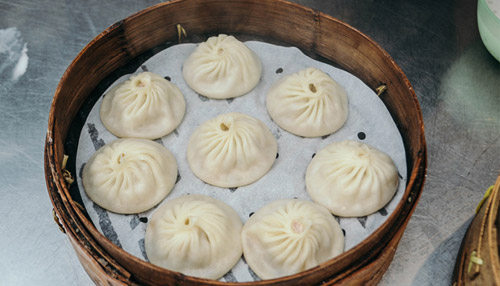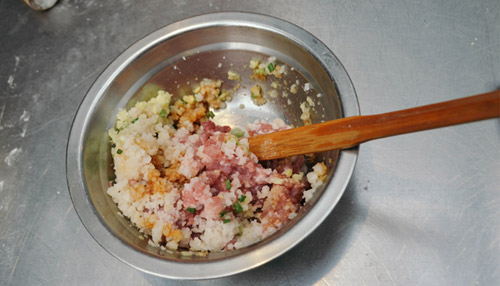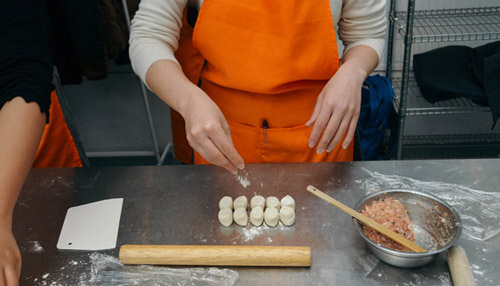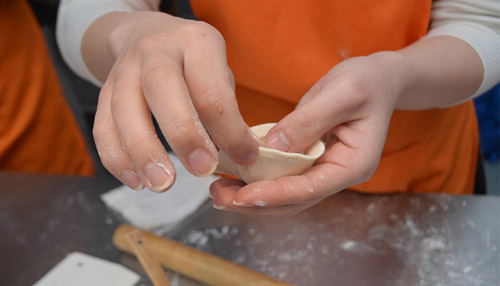East West Lifestyle
Recipes of China: Soup Dumplings from Shanghai
By Clarissa Wei

Food blogger Clarissa Wei makes Shanghai’s famous “little caged buns”— Xiaolongbaos
Shanghai holds a special place in my heart, even though I truly hate trudging through the mountains of people just to get by.
This is where I studied abroad in college and began to realize the wonders of regional Chinese food. In many ways it is where it all began. It’s where I achieved an advanced command of Mandarin; it’s where I learned about the regions of China. It’s where I wrote one of my first articles about Chinese food. And for that reason, it’s where I chose to start off my journey in Mainland China.
Truth be told though, this isn’t a city I particularly love. My relationship with Shanghai is complicated. I love her because she’s a part of my history, but she’s too metropolitan for my tastes and at 24 million people strong (in 2014), struggling through public transportation sucks out all the energy I would rather use for earnestly exploring. It’s a fascinating city for cosmopolitans. There’s a true blending of East meets West and because it’s such an economic hub, you have people from all over China and all over the world. All regional Chinese cuisine is represented here as well as global cuisines. You have trendy coffee shops right next to pristine and quiet tea studios. There are farm-to-table cafes next to huge Shanghainese chain restaurants next to hole-in-the-wall noodle joints. You have Taiwanese food, Xinjiang restaurants, Japanese sushi joints, Korean barbecue, Indian curries; Shanghai truly has it all.

"There’s a true blending of East meets West and because it’s such an economic hub, you have people from all over China and all over the world."
I haven’t been back here in years and the shops have changed dramatically. There are more buildings, even though there is just as much construction. But I know I can count on one thing being constant: the old-school xiaolongbao eateries. Those have stayed exactly the same. Some of my local favorites: Nan Xiang Xiaolong Mantou in Yu Yuan Garden (at least a century old), De Xing Guan (a chain, but a quality one) and Fu Chun (where the xiaolongbao has quite a chewy skin). For those who prefer something with a bit of a more modern vibe, I recommend The Dining Room in Xintiandi. The menu features Shanghainese classics served with the millennial in mind. What that means: manageable portions, attention to the quality of ingredients and a wonderful, quaint café atmosphere. Also, their xiaolongbaos are the bomb.
They have to be. After all, there is so much competition.
The xiaolongbao is the crowned jewel of this region of China and old-timers get a steady stream of customers no matter what day of the week it is. Even during the month of Chinese New Years, when Shanghai is largely deserted because most of the people here aren’t native to the city, the xiaolongbao restaurants are still popular places to hit up.
Translated as the “little caged bun,” the xiaolongbao originated in Shanghai and is considered a folk art. Recognized and protected by the local government, it’s everywhere in town – from the breakfast joint on the corner to the upscale eateries decked out with private booths. The key to the soup inside is a handful of pork gelatin, which should be made a couple of days before. The secret to the texture is rolling out the dough thin enough and the most difficult part of the entire process is the folding technique, which really, just takes a whole lot of practice. “Keep on practicing until the thought of the xiaolongbao makes you puke,” one Shanghainese chef told me. I haven’t quite gotten to that level yet, but I was able to fashion out little soup dumplings pretty enough to be photographed.
" Translated as the “little caged bun,” the xiaolongbao originated in Shanghai and is considered a folk art."

Here’s the recipe
Soup Dumplings from Shanghai
Prep time: 40 mins
Cook time: 10 mins
Servings: 8
Ingredients:
For the bun:- 2/3 cup all-purpose flour
- 40 mL (1/8 cup) water
- 1/2 cup of minced pork
- 1 tsp salt
- 1 tsp sugar
- 1 tsp white pepper powder
- 2 tsp rice wine
- 2 tsp light soy sauce
- 2 tsp green onion
- 2 tsp ginger
- Splash of sesame oil
- 2/3 cup of pork gelatin*, minced
*= see recipe below
- For the dough, combine flour and water. Knead until smooth. Cover with plastic wrap for 30 minutes.
- For the filling, combine the ingredients and mix well.
- Roll dough out into a long cylinder and cut into 10 equal pieces. For each piece, flatten into a ball and roll out with a rolling pin (a small one works best). Roll it out into a perfect circle then add a bit of filling in the middle.
- Pinch. Now, the pinch technique is the most complicated part of this entire recipe. Hold the dumpling with your left hand, and pinch the edge with your right. Crease with your left index finger, pinch with right, then crease with the left again. Rotate until you get the shape down. I recommend practicing with two pieces of dough in the beginning before starting off with the meat. The thinner the dough is, the easier it will be to fold.



- 2.2 pounds pork skin without fat
- 17 cups of water
- 2 cups of green onion
- 2 cups of ginger
- 2 cups of cooking wine
- Make sure all the fat is removed from the pork skin and that it’s clean. Blanch to remove impurities.
- Put all of the ingredients in a pot, so that it all fits rather snugly. Turn up the flame to high heat and bring the ingredients to a boil.
- When the water comes to a rolling boil, turn the flame down to a simmer. Keep simmering for two to three hours, until the liquid becomes sticky. Then strain, removing the pork skin, ginger and green onion.
- Chill the liquid until it becomes gelatinous. Use within two days.
Sign up for the Reach Further Newsletter
We’ll keep you in the know about the latest US-Asia business news and trends.
Suscríbase al boletín Reach Further
Lo mantendremos informado sobre las últimas noticias y tendencias comerciales entre Estados Unidos y China.

